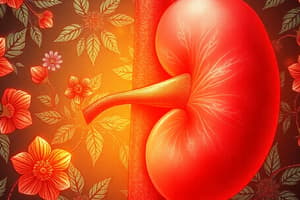Podcast
Questions and Answers
Which of the following statements about oxybutynin is correct?
Which of the following statements about oxybutynin is correct?
- Oxybutynin is excreted in the feces.
- Oxybutynin is contraindicated in patients with cardiovascular instability. (correct)
- Oxybutynin is primarily metabolized in the kidneys.
- Oxybutynin is a potent anticholinergic drug.
What is the onset of action of transdermal oxybutynin?
What is the onset of action of transdermal oxybutynin?
- 24 to 48 hours (correct)
- 4 to 6 hours
- 1 to 2 hours
- 12 to 24 hours
What is the duration of action of transdermal oxybutynin?
What is the duration of action of transdermal oxybutynin?
- 24 hours
- 96 hours (correct)
- 48 hours
- 12 hours
What is the main mechanism of action of oxybutynin?
What is the main mechanism of action of oxybutynin?
What is the recommended maximum dosage of oxybutynin for older adults?
What is the recommended maximum dosage of oxybutynin for older adults?
What are the most commonly reported CNS adverse effects of oxybutynin?
What are the most commonly reported CNS adverse effects of oxybutynin?
What are the contraindications to oxybutynin?
What are the contraindications to oxybutynin?
What is the potential interaction between oxybutynin and phenothiazines?
What is the potential interaction between oxybutynin and phenothiazines?
What is the main therapeutic effect of darifenacin?
What is the main therapeutic effect of darifenacin?
What is the metabolism of darifenacin primarily dependent on?
What is the metabolism of darifenacin primarily dependent on?
Which type of medication is considered first-line for urge incontinence?
Which type of medication is considered first-line for urge incontinence?
What medication should be used with caution in patients with hypertension due to its potential to increase blood pressure?
What medication should be used with caution in patients with hypertension due to its potential to increase blood pressure?
Which medication can decrease bladder contractions as well as increase bladder neck resistance?
Which medication can decrease bladder contractions as well as increase bladder neck resistance?
Which medication may be used to treat stress incontinence but needs to be used with caution in men with prostatic hyperplasia and in patients with hypertension?
Which medication may be used to treat stress incontinence but needs to be used with caution in men with prostatic hyperplasia and in patients with hypertension?
Which class of drugs is considered the drug of choice for their antispasmodic effects on smooth muscle to relieve the symptoms of urinary incontinence and frequency that accompany an overactive bladder?
Which class of drugs is considered the drug of choice for their antispasmodic effects on smooth muscle to relieve the symptoms of urinary incontinence and frequency that accompany an overactive bladder?
Which medication is the prototype urinary antispasmodic that is available in oral and transdermal forms?
Which medication is the prototype urinary antispasmodic that is available in oral and transdermal forms?
What is the onset of action of the oral preparation of oxybutynin?
What is the onset of action of the oral preparation of oxybutynin?
What is the peak of the oral preparation of oxybutynin?
What is the peak of the oral preparation of oxybutynin?
What is the duration of the oral preparation of oxybutynin?
What is the duration of the oral preparation of oxybutynin?
What type of interventions does pharmacologic therapy work best when used as an adjunct to?
What type of interventions does pharmacologic therapy work best when used as an adjunct to?
Which drug is indicated for the treatment of overactive bladder with symptoms of urgency, urge incontinence, and frequency?
Which drug is indicated for the treatment of overactive bladder with symptoms of urgency, urge incontinence, and frequency?
Which drug is more selective for muscarinic receptors in the urinary bladder than in other areas of the body, such as the salivary glands?
Which drug is more selective for muscarinic receptors in the urinary bladder than in other areas of the body, such as the salivary glands?
Which drug reduces the tone of smooth muscle in the bladder, exerting an antispasmodic effect?
Which drug reduces the tone of smooth muscle in the bladder, exerting an antispasmodic effect?
Which drug is well absorbed after oral administration, 98% bound to plasma proteins, and extensively metabolized in the liver by CYP3A4 enzymes?
Which drug is well absorbed after oral administration, 98% bound to plasma proteins, and extensively metabolized in the liver by CYP3A4 enzymes?
Which drug should be taken at least 1 hour before meals or on an empty stomach due to its absorption characteristics?
Which drug should be taken at least 1 hour before meals or on an empty stomach due to its absorption characteristics?
Which drug is recommended to have reduced dosages for patients with moderate renal or hepatic impairment?
Which drug is recommended to have reduced dosages for patients with moderate renal or hepatic impairment?
Which drug has the potential for interaction with other drugs that are eliminated by active tubular secretion, resulting in increased serum concentration of either the drug or the coadministered drug?
Which drug has the potential for interaction with other drugs that are eliminated by active tubular secretion, resulting in increased serum concentration of either the drug or the coadministered drug?
Which drug is not recommended for patients with severe hepatic impairment?
Which drug is not recommended for patients with severe hepatic impairment?
Which drug is available in an extended-release form?
Which drug is available in an extended-release form?
Which drug may prolong QT intervals, especially at higher dosages, potentially resulting in dysrhythmias?
Which drug may prolong QT intervals, especially at higher dosages, potentially resulting in dysrhythmias?




